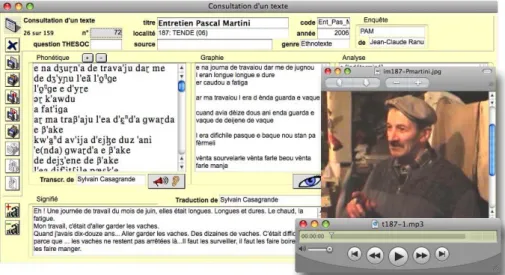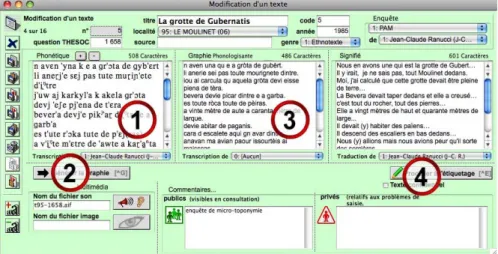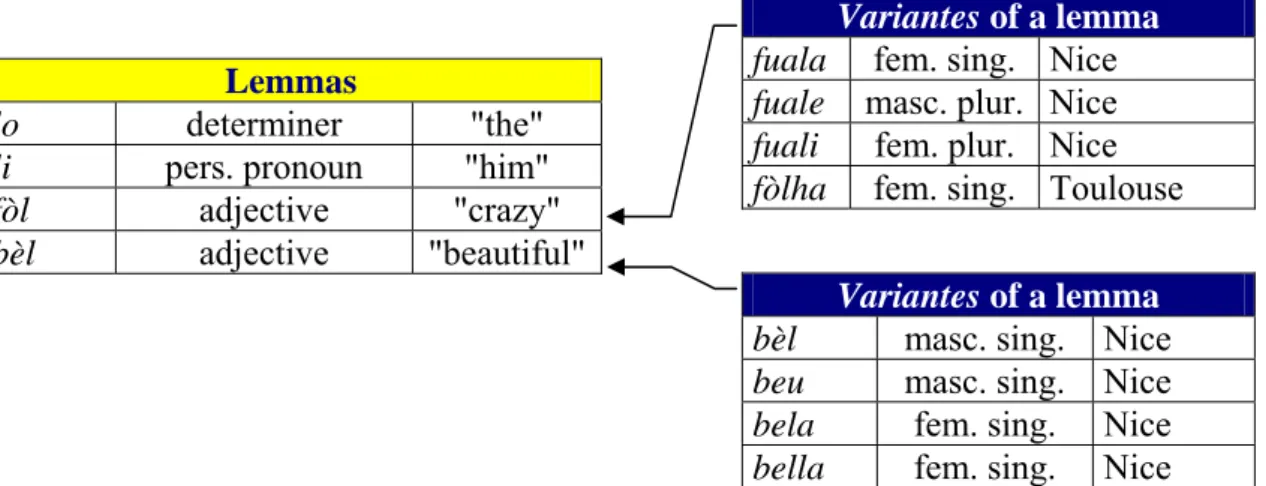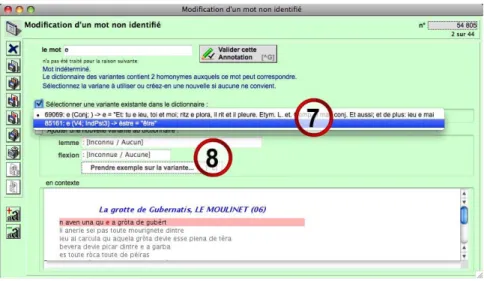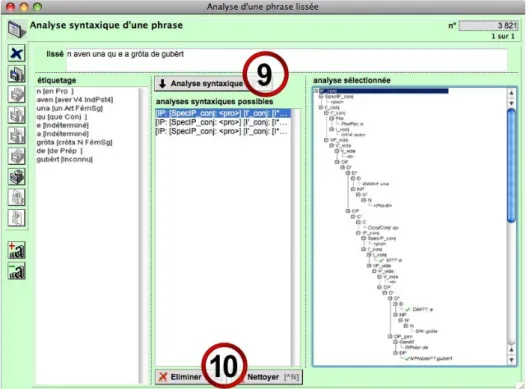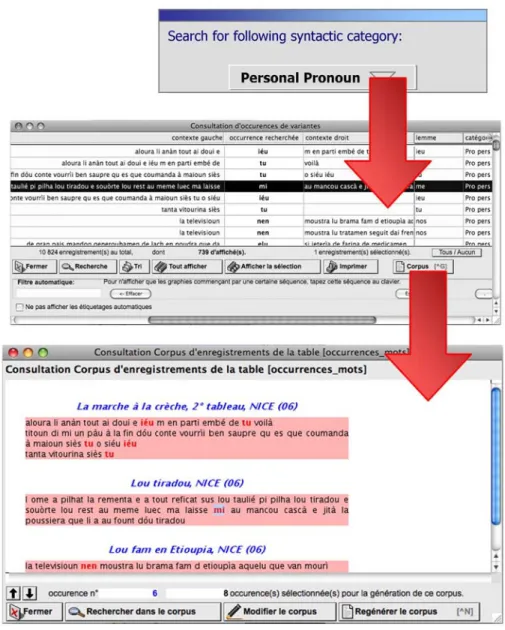HAL Id: hal-01277767
https://hal.archives-ouvertes.fr/hal-01277767
Submitted on 23 Feb 2016
HAL is a multi-disciplinary open access archive for the deposit and dissemination of sci-entific research documents, whether they are pub-lished or not. The documents may come from teaching and research institutions in France or abroad, or from public or private research centers.
L’archive ouverte pluridisciplinaire HAL, est destinée au dépôt et à la diffusion de documents scientifiques de niveau recherche, publiés ou non, émanant des établissements d’enseignement et de recherche français ou étrangers, des laboratoires publics ou privés.
The Thesaurus Occitan: a multimedia database
dedicated to occitan dialects.
Pierre-Aurélien Georges
To cite this version:
Pierre-Aurélien Georges. The Thesaurus Occitan: a multimedia database dedicated to occitan di-alects.: Presentation of its morphosyntax module.. Tools for Linguistic Variation (EUDIA-2), Oct 2009, Vitoria Gasteiz, Spain. pp.107-118. �hal-01277767�
THE THESAURUS OCCITAN :
A MULTIMEDIA DATABASE DEDICATED TO OCCITAN DIALECTS
PRESENTATION OF ITS MORPHOSYNTAX MODULE
Pierre-Aurélien Georges Laboratoire BCL, CNRS UMR 6039
Université Nice Sophia-Antipolis, MSH de Nice (France) pageorge AT unice.fr
Abstract
The Module MorphoSyntaxique (abbreviated MMS) is a computer tool especially designe d for syntactic and morpho-syntactic analysis of Occitan dialects.
It is part of the Thesaurus Occitan multimedia database (of which a general presentation can be found in these proceedings in another article by Guylaine Brun-Trigaud).
Following the THESOC’s general guidelines (i.e. localised and oral data only), this module contains both oral texts (including ethnotexts) and single sente nces, such as answers to m orphosyntactic questionnaires.
The “oral data” criteria can be somewhat flexed: even if this module was originally conceived for oral data processing, its part-of-speech tagger and syntactic parser are still able to process written texts so far as they are written in a familiar or popular style, close to oral register.
The locations where all these texts and se ntences have been harvested are stored in the database, thus enabling on the long term a com parison between different dialects on a morphosyntactical or syntactical basis, thus opening new perspectives for dialectology.
Keywords
Comparative syntax ; morphosyntax ; Occitan dialects ; ethnotexts corpus ; database
1. General Presentation
The THESAURUS OCCITAN (abbreviated THESOC) is a m ultimedia database which encompasses oral d ialectal data from the whole Occitan dom ain. Aside from its lexical and microtoponymy corpuses, the THESOC also contains a m odule dedicated
to morphosyntax and syntax an alysis of Occitan dialects 1. This Module MorphoSyntaxique (MMS)2 database is aimed at studying oral syntax and
morphosyntax in a comparative way.
1 For a general presentation of all the other aspects of the THESOC, please refer to the article b y
Guylaine Brun-Trigaud also included in these proceedings, and/or (Georges, not yet published, a).
2 It was formerly known as « base TEXTES » in (Georges, 2009) because it o riginally started has a
1.1. Conditions
As for the rest of the T HESOC, raw data to be included in this MMS module must
match the two following criterions:
• Location condition: linguistic data m ust be precisely located. This constitutes an essential condition for diatopic variation studies. In particular, this condition will enable dynamic and automated generation of linguistic maps on demand in the future.
• Orality condition: linguistic data should com e from oral sources. Indeed, our philosophy here is to integrate linguistic facts collected under oral form (with IPA transcription), which guarantees the reality of these facts und er consideration. Moreover, the T HESOC allows hearing of the audio tracks
recorded during the field works, th us giving to the user the possibility to control or to check the proposed transcription.
1.2. Different types of data
On the one hand, the database contains a co llection of single sentences or isolated sentences: answers to morphosyntact ic questionnaires such as PAM 3, sentences found in unpublished survey notebooks of the Atlas linguistiques4, or sentences
published in some of these atlases, such as the ALMC5.
On the other hand, the database also cont ains a collection of texts, such as
ethnotexts collected on the field, or radio broadcastings.
Similarly to the other parts of the THESOC, multimedia documents such as pictures,
sound files, or video files, can be attached to a text or a single sentence.
1.3. Text types and orality condition
Although this m odule was originally conc eived for treating oral data only, its lemmatiser and syntactic parser presente d in sections 2.2. and 2.3. are even capable of treating written texts as long as they are written in a fam iliar or popular sty le, close to o ral register; thus dimm ing somewhat the o rality condition required in section 1.1. This orality condition may then be eventually reform ulated as th e following: linguistic data must contain oral syntax or popular / close-to-oral syntax.
This possibility has allowed us to extend the corpus with other types of texts: some theater plays, articles from popular press, etc. However, each tex t record from the database contains a field that inform s the user about its type / gender. As shown in Figure 1, Ethnotexts are thus easily identifiable by the “genre: Ethnotexte” field content, whereas other types of texts ha ve another tag in th is field, such as “Chanson” (song lyrics) or “Presse” (press articl e) for example. Thanks to this field, it’s always possible to filter out written texts and to focus only on ethnotexts and/or some other types of oral texts: search queries can be configured to show results from the whole corpus or from only certain types of texts specified by the user. This way, linguists can decide whether to stay on strictly oral data, or to also include some type of written texts in order to get a broader corpus.
3 Parler des Alpes Maritimes, supervised by (Dalbera, 1994).
4 Atlas Linguistiques de la France par régions, éditions du C.N.R.S, as presented in (Séguy, 1973). 5 Atlas Linguistique du Massif Central, (Nauton, 1957-1963)
Fig. 1: example of an ethnotext record.
2. Data processing
2.1. Adding new data to the corpus
Data can be added to the database through its XML import / export functionalities6
or by typing new records directly within the user interface.
The graphical transcription fi eld of a new reco rd can have two different origins, depending on the nature of this record:
- if it’s a tex t (written in a familiar or popular style, close to oral register), for which a graphical transcription is, by definition, already available, it is directly stored in the database, whatever writing conventions or writing system have been used b y its au thor, since th ere is no uniq ue official s pelling norm (or “orthographe”) for the Occitan dialects as is the case for French or English, but rather several writing systems that competes7. The database also contains an algorithm which tries to au tomatically detect which w riting system has been used within a text8, for users’ information.
- if it’s based on a sound track recorded on the field, for which the user doesn’t already posses a grap hical transcription (as is typica lly the case with
ethnotexts), it’s possible to easily ge nerate a phonological graphical
transcription: the user simply presses on a button (button #2 shown in Figure 2 below) to call an automated transcriber which is available in MMS (as in the rest of the THESOC), that generates a graphical tr anscription (#3) directly from
the IPA transcription (#1), which must therefore be typed or imported in the database first. This autom ated transcription is based on conversion rules that
6 Thus, TEI import / export can also be achieved by using an XSLT filter.
7 The three most common writing systems used are “ graphie alibertine”, as defi ned by (Alibert,
1966), “graphie mistralienne” as in (Mistral, 1979), and in a far smaller proportion, the Eastern part of Occitania sometime uses “graphie italianisante”, which is inspired from Italian’s writing system.
8 This is based on statistical o ccurrences of some sequences of letters, and these rules are
user-customizable, therefore, any new writing system can be added to this automated recognition feature. Should this algorithm ever fail, on a very short text for example, where the situation is unclear, it is always possible to override it and to manually specify the correct writing system used by the text.
can be m odified by the user and adap ted to different phonological systems among dialects, so that the transcriber will automatically use different rule sets to transcribe different dialectal areas , depending on the inform ation given by the locality field of the record to be processed. The result is a phonological graphical transcription close to (Mis tral, 1979)’s writing system known as “graphie mistralienne”, which provides users a more readab le way to access the content of the text, and allows a first level of abstraction that “smoothes” or “hides” phonetic variation9.
Fig. 2: processing a text record.
In both cases, all further linguistic tr eatments proposed by the different tools available in MMS are based on this graphical transcription. Thus, while these tools were originally conceived for oral data processing, they are even able to process written texts so far as they are wr itten in a familiar or popular style, close to or al register. This is how it is even techn ically possible to introduce “oral-style” written texts in the database.
Among these tools, the part-of-speech tagger and the syntactical parser automate a great amount of the annotation work, thus simplifying processing of new data, as shown in following sections.
9 Since the objective of M MS is to study syntax and morphosyntax, it’s not a major issue here to
Variantes of a lemma
fuala fem. sing. Nice fuale masc. plur. Nice fuali fem. plur. Nice fòlha fem. sing. Toulouse
Lemmas
lo determiner "the" li pers. pronoun "him" fòl adjective "crazy" bèl adjective "beautiful"
Variantes of a lemma
bèl masc. sing. Nice beu masc. sing. Nice bela fem. sing. Nice bella fem. sing. Nice 2.2. Lemmatisation process
The next step after importing or typi ng new data in the database is the lemmatisation process (button #4). Th e part-of-speech tagger identifies each individual lexical element of a sen tence or a text by us ing a reference dictionary embedded in the database.
In order to m anage efficiently the variation in all its aspects (graphical, dialectal, or inflectional variation), this dictionary is structured into two hierarchical levels: the
variantes, which are in fact the lexical occurrences found in the corpus, are grouped
under lemmas. This allows perform ing searches or linguistic treatments either on a particular form (e.g. s uch inflection, with such graphical transcription, in such dialect), or on all form s associated to a given lemma. Figure 3 be low illustrates this two-levels dictionary structure:
Fig. 3: database’s dictionary structure.
This schematic illustrates the different types of variation handled:
- phonological variation, between bèl (preceding a vowel) et beu (preceding a consonant) in the dialect of Nice, called “Nissart”
- dialectal variation, between fòlha in Toulouse’s dialect and fuala in Nissart, - graphical variation, in Nissart, between bela and bella,
- and inflectional variation, also in Nissart, between fuala, fuali and fuale.
As reference forms, lemmas’ graphical form s are based on entries from (Alibert, 1966) when available10 whereas the variantes part of the dictionary is currently
populated by entries coming both from the lexical database of the THESOC and from a
set of several paper dictionaries, such as (Eynaudi, 1932), that have been digitalized and integrated in the d atabase for this purpose. Moreover, the process of m anual lemmatisation of unidentified lexical items sometimes adds new entries to th e dictionary, as detailed below in this section, as well as the syntactical-tree annotation of sentences. Thus, dictionary’s content is constantly improved by the lemmatisation process of new texts and/or sentences and new entries com ing fromTHESOC’s lexical
database.
10 When there is no corresponding entries in (Alibert, 1966), an asterisked form is p roposed in
As illustrated in Figure 4 below, the output o f the lemmatis ation process (#5) shows the following inf ormation about each lexical item identified in the tex t or sentence processed: its lemma, morphosyntactic category, and inflection. Some items may remain unidentified after the lemmatisatio n process, either becaus e there is n o matching entry in database’s d ictionary or b ecause there are sev eral potential candidates.
Fig. 4: lemmatisation process.
As can be seen in Figure 4, unknown item s are tagged “Inconnu” (as is the case of proper noun “ Gubèrt”) whereas ambiguous item s are tagged “ Indéterminé”: the graphical form “e” can match either with an inflected form of the verb èstre “to be” (3rd Pers. Sing.) or with the conjunc tion coordination “and” ; sim ilarly, “a” can
match either the definite de terminer (Fem. Sing.) or an inflected form or the verb
aver “to have” (3rd Pers. Sing.).
When a lexical item was not cor rectly identified or not id entified at all by th e lemmatisation process, the two buttons labe lled #6 in Figure 4 allows to manually identify this lexical item. In the case of ambiguous item, with several potential matching candidates in databa se’s dictionary, the user can choose the right entry within a lis t of these potential ca ndidates as shown by #7 in Figure 5. If the unidentified lexical item has no correspondin g entry in the dict ionary, it’s also possible to add a new entry in the dictionary (#8) and to identify the lexical item with this new entry (these two points are reali zed at a glance, as one single operation). This unique user interface also shows the unidentified lexical item in context (bottom of Figure 5) to ease its manual identification by the user.
Fig. 5: annotation of ambiguous items.
After lemmatisation process has been performed, the next step is syntactical-tree tagging, eased by MMS’ syntactical parser. It is not necessary here to lemmatise each single lexical item of a senten ce or a tex t before using MMS’ s yntactical parser: if 80 % or 90 % of the lexical item s have been correctly lem matised, this is enough to switch to next step, as will be explained below.
2.3. Syntactical tree tagging
MMS’ syntactical parser uses both data generated by the lemmatisation process and the embedded dictionary of the database in order to propose one or several possible syntactic structures for each s entence11, thus autom ating in som e proportion the
syntactical-tree tagging proce ss. The syntactic trees are generated in a generativist theoretical framework, but th e syntactic rules on which the parser relies are user-customizable12.
Figure 6 below gives an example of this process. On the left pane, the results of the lemmatisation process are s hown. By clicking on the bu tton #9, the user calls the syntactical parser, which analyses the se ntence and output som e possible syntactic structures in a list shown just under this button. The user must then browse a mong these candidates and chose the correct hierarchical syntactic structure(s) that really correspond to this sentence: by clicking on a candidate structure within the list, the hierarchical representation of the select ed structure is shown in th e right pane13.
Since the c andidates list is so rted by probability (m ost probable c andidates are located on top of the list, whereas least probable ones are at the bottom ), users therefore typically only need to look at the two or three first propositions to find the correct one(s).
Thanks to the two buttons under #10, false candidate structures are then eliminated in order to keep only the co rrect one, or the two or three right one s (when there’s an
11 Wether it’s an isolated, single sentence, or a sentence from a text.
12 The only main constraint is that generated syntactical trees must have binary branching nodes. 13 Please note here that the syntactical tree s tructure (in the right pane) is displayed vertically instead
of the traditional horizontal presentation. This is due to some technical limitations we are currently working on.
ambiguity in the sentence that can not be re solved, for example if the author of this sentence has deliberately made a play on words). If the appropriate structure(s) is/are not present in the list genera ted by the syntactical parser, the user can choose any proposed candidate and edit th is structure in order to manually build the correc t hierarchical tree(s).
Fig. 6: syntactical structure annotation.
The use of MMS’ syntactical parser thus simplifies and speeds-up the syntactical-tree tagging task by providing the user a semi-automated way of generating hierarchical structures. Moreover, it also simplifies and speeds-up the lemmatisation process: Figure 6 shows for exam ple that the unknown proper noun “ Gubèrt”, that had been n either correctly identified by the a utomated lemmatiser nor manually tagged by the user, has nevertheless been correctly identified as a proper noun by the syntactical parser. Similarl y, the am biguous elements “e” and “ a” have been successfully identified as respectively an inflected verb and a determ iner. Therefore, the syntactical parser can autom atically “guess” some lexical item s that remained unidentified after the lemmatisation pro cess, and disam biguate some ambiguous lexical items, thus also sim plifying the lemmatisation task, since it’s no longer mandatory to tag 100 % of all the lexical items of a sentence.
After these 10 steps have been perfor med, annotation process is now com plete: each lexical item of each sentence has been lemmatized, and each sentence is tagged with one or several hierarchical syntactic structure(s). Data are then ready to be exploited through different work features offered by the database.
3. Work features
3.1. Search engine
Once the sentences and texts from the database have been annotated with the help of these tools mentioned in section 2., MMS provides several search options to select data with different criterions. For example, it’s possible to search all occurrences:
- of a given variante
- of all variantes associated to a given lemma
- of all variantes with one or several given morphosyntactic categories - of a given sequence of part-of-speech categories14
- of a given location15
- having a graphical similarity with a given lemma or variante.
It’s also possible to perform searches based on syntactical tree tagging previously processed: one can search for all sentences containing a particular syntactic structure or syntactical tree fragment, such as all sentences containing a DP within another DP for example. When an ambiguous sentence has several syntactic structures associated to it, such a search query will show this sentence in the s earch results if it matches any of its associated structures.
As illustrated in Figure 7, the results are shown in context: the list of matching occurrences is presented in colum n, and each matching occurrence is disp layed within the full original sentence where it is coming from.
3.2. Automated work corpus generation
Whichever search query is for mulated, a work corpus can then be autom atically generated from these s earch results16. As presented in Figure 7, it is possible, for
example, to search for all occurrences with morphosyntactic category « personal pronoun », then to select som e particularly interesting ones in the results list displayed17, and to auto matically generate a work co rpus in which the se selected
occurrences are high lighted in th eir original context: text title 18, location, full
sentence or full tex t where the term occurs. In this example, we chose to generate a “concise” work corpus, i.e. only m atching sentences are being extracted and displayed gathered, but it is also possible to generate a “f ull” work c orpus, which gathers both matching isolated sentences and the full texts that contains at least one sentence containing one occurrence matching the search query.
14 Some wildcard options are available, such as “Beginning of se ntence only” / “End of sentence
only”.
15 This is, all occurrences of all texts associated to a particular given location
16 Except if the search query concerns all occurrences of a given location, because this would generate
a full list of all texts and isolated sentences coming from this location, and thus would have merely no interest here since it is already possible to get this information from elsewhere in the database.
17 Of course, it’s also possible to select all occurren ces from the results list in order to generate an
exhaustive work corpus from the database.
Fig. 7: search by syntactic category and work corpus generation features.
In the sam e way, one can generate a work corpus from search results based on syntactical tree tagging previously proce ssed. These work corpuses can be exported and saved as RTF or Microsoft Word format for further exploitation.
3.3 User-customizable taggings
In 2009, a new feature has b een added to MMS: users now have the ability to attribute some user-defined “tags” to some sentences of the database 19. Then, it’s
possible to perform cross searches based on these tags within the data base. This allows, among other things, to search fo r presence or absen ce of a correlation between two or several lingui stic parameters, confirming or invalidating user’s hypotheses20.
It’s possible, for example, to search within the database for texts that contain at least one sentence with a given tag but do not contain any sentences with another given tag (evaluating a hypothetical positive correlation between two parameters within the same speaker, therefore the same idiolect). Another use would be to search within the database for locations for which there is at least one sentence with a given parameter (no lexically realised subj ect pronoun, for example) and also at least one sentence with another given param eter in the sa me location (evaluating an hypothetical negative correlation between two parameters within a dialect).
In a generative theoretical framework, one could for example use this feature to try to check if (Rizzi, 1982)’s correlation between pro drop and free inversion of subject and verb can be verified (or invalidated) on the field by dial ectal data, such as Occitan dialects21.
Conclusion
The MMS module of the THESOC contains flexible tools and features that can be used
of several maners and under different theo retical frameworks. Therefore it can fully play its role of a computer tool aiding s yntactical and morphosyntactical research on Occitan dialects on a comparative basis.
Currently, we are working on adding carto graphic functionalities to MMS, that would fosters the use of MMS for diatopi c variation study, gi ving the users the opportunity to visualize vari ation of som e syntactic or morphosyntactic features among the occitan dom ain and the possibi lity to generate m aps on dem and to illustrate and to support their hypothesis.
Aside from the diatopic perspective, the data entries in the database also contain a “date” field to indicate for each text and each single sen tence, at which date th ey have been collected on the field. So, if enough data is available, it would be theoretically possible to study variation also from a diachronic point of view.
19 Whether isolated sentences or sentences from a text.
20 For some interesting applications of th is feature and concrete cases, cf. (Georges, not ye t
published, b)
21 Dialects from the northern part of Occitania show overt pronoun subjects, whereas the majority of
the Occitan dialects are pro drop. Comparing these Occitan dialects, which are all closely related, within a microvariational approach, could therefore shed new light on this hypothetic correlation.
References
Alibert, Louis, 1966, Dictionnaire Occitan-Français d'après les parlers
languedociens, Toulouse: Institut d'Etudes Occitanes.
Dalbera, Jean-Philippe, 1994, Les parlers des Alpes-Maritimes, étude
comparative, essai de reconstruction, Association Internationale d'Etudes Occitanes.
Eynaudi, Jules, 1932, Dictionnaire de la Langue Niçoise, Imprimerie de
"l'Eclaireur de Nice", Nice.
Georges, Pierre-Aurélien, 2009, Présentation de la base Textes associée au
THESOC, actes du colloque La dialectologie hier et aujourd'hui (1906-2006), Lyon,
2006, Brigitte Horiot (Ed.). pp. 81-94.
Georges, Pierre-Aurélien, not yet published, a, Le THESOC: bases de données et
outils d'analyse consacrés à l'étude des dialectes occitans, actes du colloque Bases
de données, Méthodes, Modèle s de description: de nouve lles perspectives pour la recherche sur les langues régionales et minoritaires? Tübingen, 2008, Stauffenburg Verlag (DeLingulis).
Georges, Pierre-Aurélien, not yet published, b, "Les ch aînes de clitiques: l'outil
informatique au service de l'analyse comparative", in: actes du colloque Mémoires du
terrain: enquêtes, matériaux, traitement des données (Lyon, 2009).
Mistral, Frédéric, 1979, Lou Tresor Dóu Felibrige ou Dictionnaire
Provençal-Français, Raphèle-lès-Arles: Culture Provençale et Méridionale.
Nauton, Pierre, 1957-1963, Atlas Linguistique et ethnographique du Massif
Central, Editions du CNRS, Paris.
Oliviéri, Michèle, 2003, Constitution d'une base de textes occitans, 36ème
colloque de la Societas Linguistica Eur opaea : Linguistiqu e et Corpus, Lyon, 4-7 septembre 2003.
Rizzi, Luigi, 1982, Issues in Italian Syntax, Dordrecht, Foris.
Séguy, Jean, 1973, "Les atlas linguistiques de la France par régions", in: Langue
